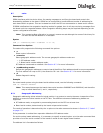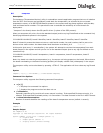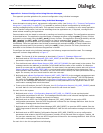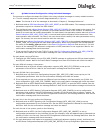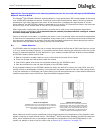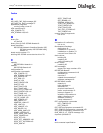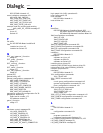
181
Dialogic
®
DSI SS7MD Programmer’s Manual Issue 3
A.3 Q.SAAL Protocol Configuration Using Individual Messages
The process to configure the board for Q.SAAL links using individual messages is closely related to section
A.1. The full message sequence is shown diagrammatically in Figure 4.
Note: The format of all of the messages is described in Chapter 6, "Message Reference".
1. Build and send an SSD Reset Request (SSD_MSG_RESET) to the SSD module. This message contains the
parameters required to initialize the SSD module.
2. Then build and send a Board Reset Request (SSD_MSG_RST_BOARD) for each board in the system. This
message contains the address (or identifier) of the board and the name of the codefile. It causes the
board to be reset and the codefile downloaded. For each board, the application should wait until a Board
Status Indication (SSD_MSG_STATE_IND) is received and inspect the status field to determine if the
reset operation was successful. On failure, the user should check carefully the ssdm parameters and try
again. On success, the user should continue with the next step.
3. Build and send a Board Configuration Request (MGT_MSG_CONFIG0) to the onboard management task
(MGMT_TASK_ID) to configure the basic board parameters. When using Dialogic
®
DSI SS7MD Boards,
the value of the config_type parameter in the Board Configuration Request must be set to 3. For this
version of the message, the automatic configuration of MTP parameters is not supported. Wait for the
confirmation message and check the status.
4. To set up the LIU and port for the T1/E1/J1 ports, the LIU Configuration Request (LIU_MSG_CONFIG)
should be used. Wait for the confirmation message for each LIU and check the status.
For each board running ATM links:
5. Configure the ATM module using a ATM_MSG_CONFIG message to configure the ATM per board options
and VPI/VCI masks. Wait for the confirmation message from each ATM module and check the status.
For each ATM cell stream in the system:
6. Build and send an ATM cell stream configuration request (ATM_MSG_CFG_STREAM) to set up the
parameters of the ATM link. Wait for the confirmation message and check the status
For each Q.SAAL link in the system:
7. Build and send a Q.SAAL Link Configuration Request (QSL_MSG_CFG_LINK) to set up the per link
configuration parameters. Wait for the confirmation message and check the status.
8. If the required per link timer values are different from the defaults, build and send a per Q.SAAL link
timer configuration (QSL_MSG_CFG_TIMERS). Wait for the confirmation message and check the status.
9. Build and send an MTP3 Module Reset Message (MTP_MSG_RESET) to reset the MTP3 module. See the
MTP3 Programmer's Manual for the message definition. Wait for the confirmation message and check the
status.
10. Build and send an MTP3 Module Configuration Request (MTP_MSG_CONFIG) to set up configuration
parameters that relate to the MTP3 environment (number of link sets and links to support, module_ids
for user part modules etc.). See the MTP3 Programmer's Manual for the message definition. Wait for the
confirmation message and check the status.
For each link in the link set, perform the following:
11. Build and send an MTP3 Signaling Link Configuration Request (MTP_MSG_CNF_LINK) to set up
configuration parameters for the individual link. See the MTP3 Programmer's Manual for the message
definition. Wait for the confirmation message and check the status.
For each link set in the system, perform the following:
12. Build and send an MTP3 Link Set Configuration Request (MTP_MSG_CNF_LINKSET) to set up
configuration parameters for the individual link set (for example, local and adjacent point codes and the
number of links in the link set). See the MTP3 Programmer's Manual for the message definition. Wait for
the confirmation message and check the status.
13. For each destination that needs to be accessed (including all adjacent signaling points), build and send
an MTP Route Configuration Request (MTP_MSG_CNF_ROUTE) to set up configuration parameters for the



